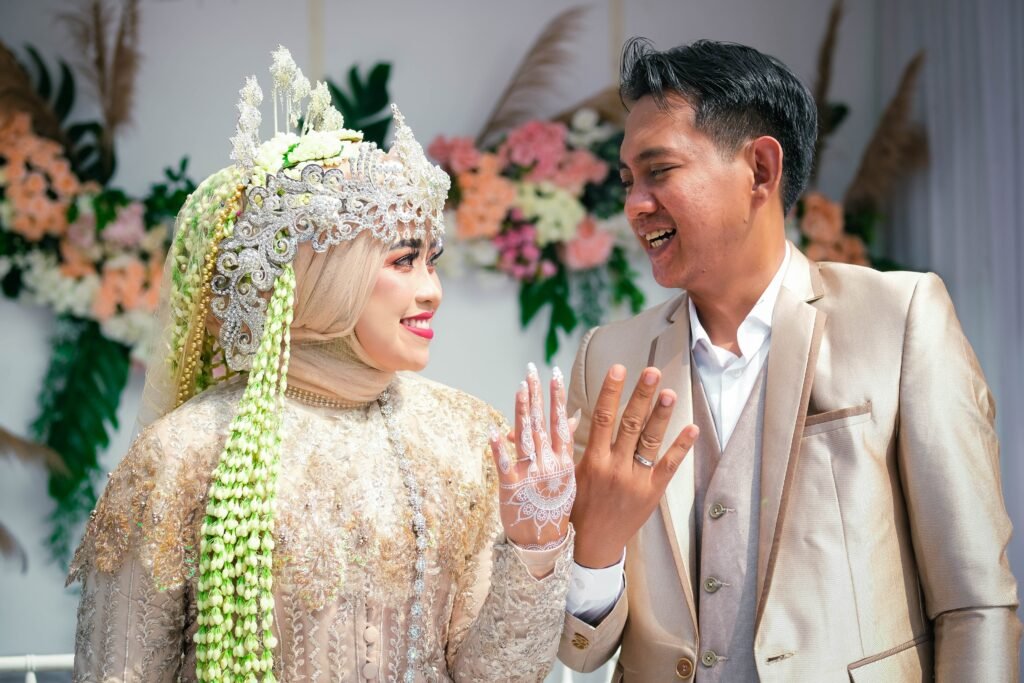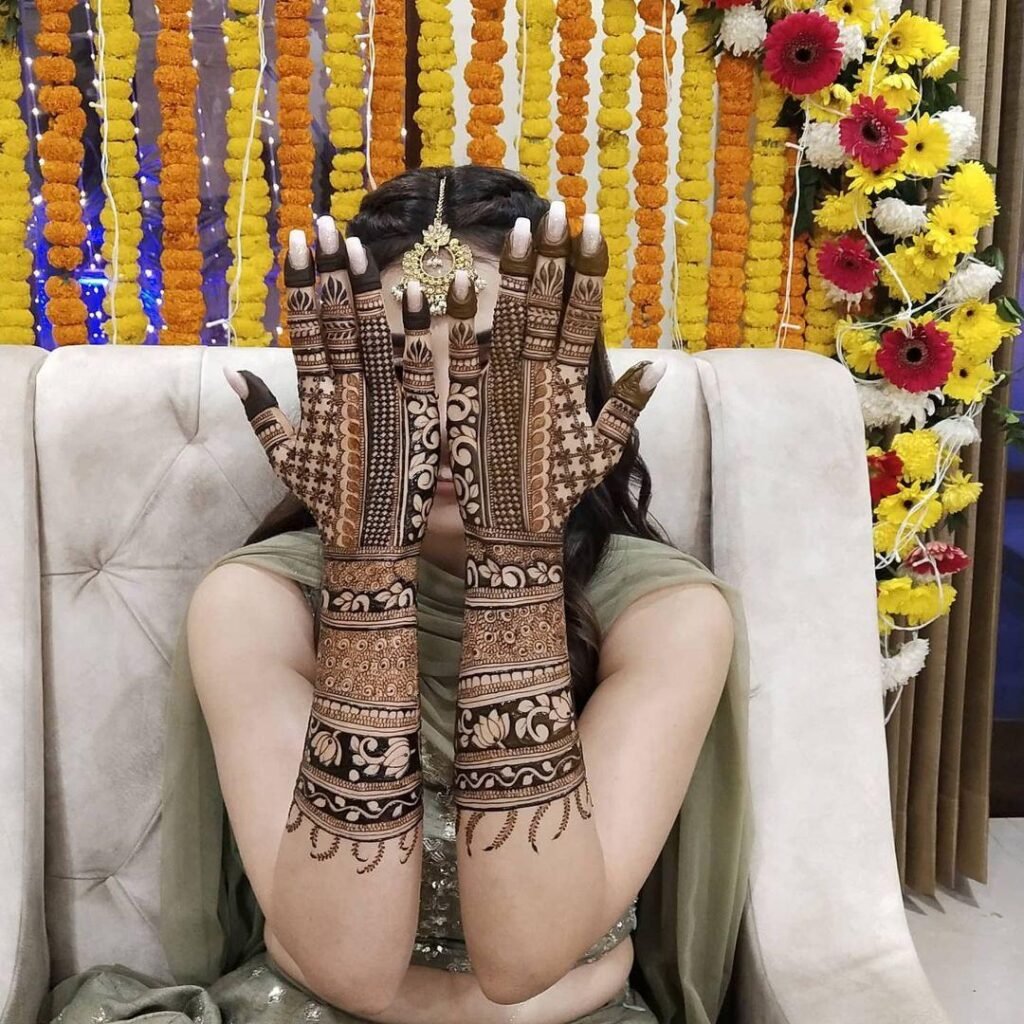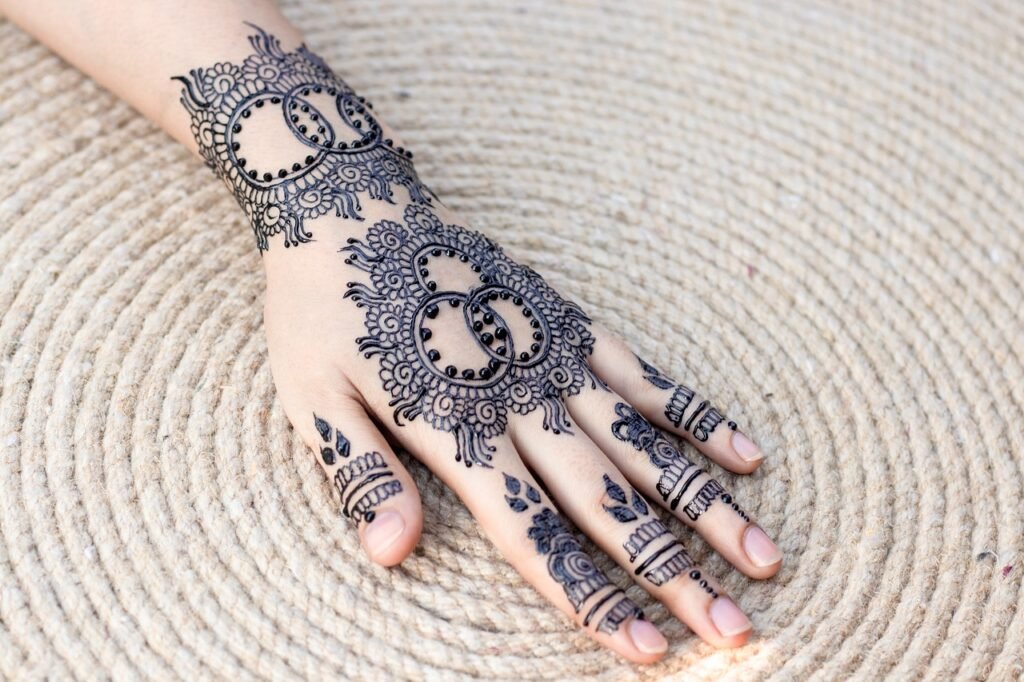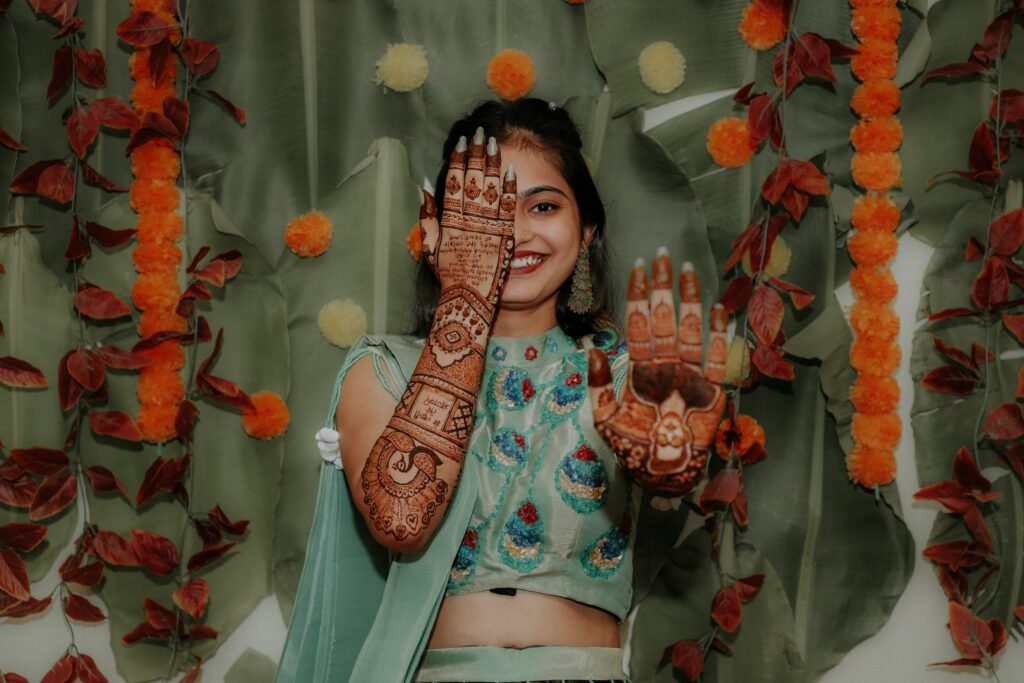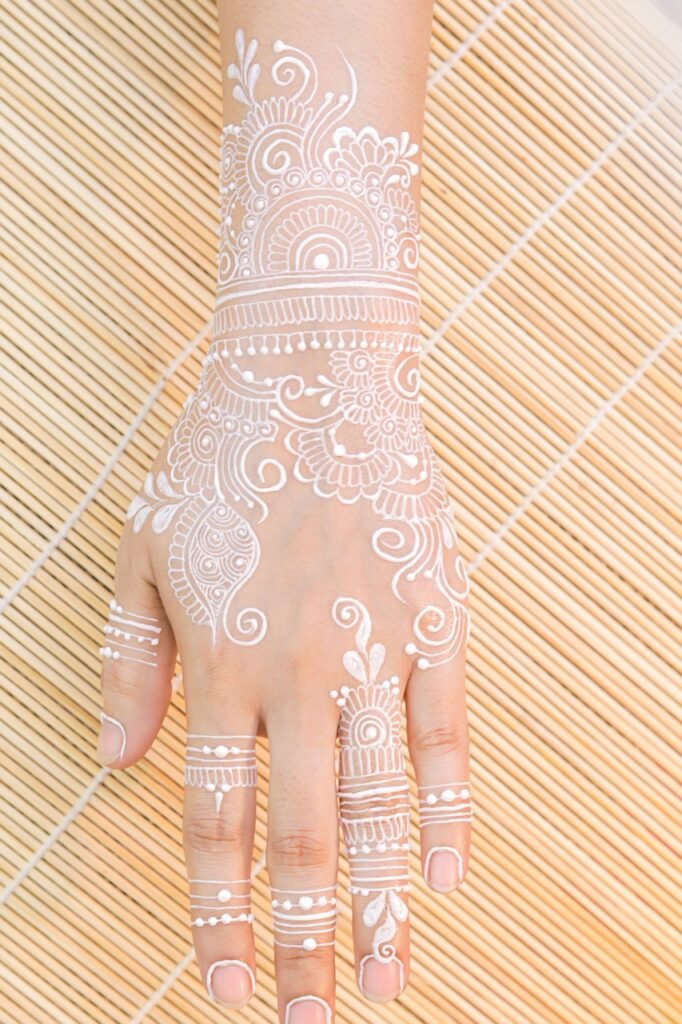- You have no items in your shopping cart
- Continue Shopping
Mehndi, or henna, has transcended time as a cultural adornment, with back hand mehndi design emerging as a canvas of intricate artistry. In this comprehensive guide, we embark on a journey through the origins, cultural significance, diverse styles, and application techniques of back hand mehndi design. Whether you’re a bride-to-be, a mehndi enthusiast, or someone seeking to understand the beauty behind this ancient art, this exploration is your gateway to the world of captivating designs.
The Roots and Richness of Back Hand Mehndi Designs
Historical Tapestry:
Back hand mehndi designs have a rich historical tapestry that spans across civilizations. From ancient Mesopotamia to the Mughal era in India, the application of mehndi has been a symbol of celebration and joy. Understanding the historical roots adds depth to the appreciation of the artistry found in back hand mehndi designs.
Cultural Symbolism:
Dive into the cultural symbolism embedded in back hand mehndi designs. Beyond the aesthetic appeal, these designs often carry profound meanings. From fertility symbols to representations of love and commitment, back hand mehndi designs serve as a visual language, expressing sentiments and cultural values.
Exploring the Diverse Styles of Back Hand Mehndi Designs
Floral Extravaganza:
Floral patterns in back hand mehndi designs have stood the test of time. Dive into the enchanting world of roses, lotuses, and intricate vines that grace the back of hands. These designs not only exude natural beauty but also symbolize growth, femininity, and the vibrancy of life.
Geometric Harmony:
For those drawn to modern aesthetics, geometric back hand mehndi designs offer a contemporary allure. Explore the precision of symmetrical lines, triangles, and intricate shapes that come together to create visually stunning patterns. Geometric designs blend tradition with a modern twist, making them versatile for various occasions.
Traditional Motifs Reimagined:
Traditional motifs like peacocks, paisleys, and elephants take on new life in back hand mehndi designs. Discover how these timeless symbols are reimagined to tell unique stories. Whether it’s a peacock symbolizing beauty or an elephant representing strength, traditional motifs connect the wearer to cultural heritage.
Mandalas: A Spiritual Journey:
Embark on a spiritual journey with mandala-inspired back hand mehndi designs. Mandalas, with their concentric circles and intricate details, add a touch of mystique. Delve into the symbolism of unity and harmony as these mesmerizing patterns create not just designs but spiritual experiences.
Crafting the Perfect Back Hand Mehndi Design
Personalization:
Uncover the beauty of personalization in back hand mehndi designs. From intricate initials to symbols with personal significance, customization allows individuals to infuse their unique personality into the art. Whether you’re a minimalist or a lover of elaborate designs, the back hand becomes your canvas for self-expression.
Application Techniques:
Behind every stunning back hand mehndi design is the skillful application by a mehndi artist. Explore the techniques such as shading, stippling, and fine lines that add depth and dimension to the designs. Mastery of these techniques ensures that each back hand mehndi design is a masterpiece.
Fusion of Tradition and Innovation:
Witness the evolution of back hand mehndi designs as tradition meets innovation. Discover how artists are pushing boundaries, blending cultural elements with modern aesthetics. This fusion creates a dynamic range of choices, ensuring that back hand mehndi designs cater to diverse tastes and preferences.
Celebrating Life’s Milestones with Back Hand Mehndi Designs
Wedding Elegance:
For brides, back hand mehndi designs are an integral part of the wedding ritual. Explore the elaborate designs that grace the hands of brides, telling stories of love and commitment. The intricate patterns not only add to the beauty of the bride but also symbolize the auspicious nature of the occasion.
Festivals and Back Hand Mehndi:
Dive into the festive fervor as back hand mehndi designs take center stage during celebrations. From Diwali to Eid, mehndi becomes a symbol of joy and festivity. Discover how the vibrant patterns enhance the celebratory atmosphere, connecting individuals to cultural traditions.
Rites of Passage:
Back hand mehndi designs are not reserved for weddings alone. Explore how individuals are embracing mehndi to mark other significant life events. From baby showers to milestone birthdays, mehndi becomes a means of celebrating and commemorating these special moments.
Emotional Connection and Therapeutic Benefits
Rituals and Bonding:
Experience the emotional connection that comes with the application of back hand mehndi designs. For brides, the process is often a cherished pre-wedding ritual surrounded by family and friends. The laughter, music, and shared stories create lasting memories, turning the application into a joyous celebration.
Therapeutic Influence:
Beyond aesthetics, discover the therapeutic properties of mehndi. The cooling effect of henna is believed to have a calming influence, making the application process a soothing experience. In some cultures, mehndi is associated with good luck and protection from negative energy, adding to its holistic appeal.
Temporary Beauty, Lasting Impressions:
Appreciate the transient beauty of back hand mehndi designs. Unlike permanent tattoos, mehndi fades over time, allowing individuals to experiment with different designs without a long-term commitment. This temporary nature adds an element of excitement and change to the art of mehndi.
Caring for Back Hand Mehndi Designs
Post-Application Care:
Ensure the longevity and vibrancy of your back hand mehndi designs with proper care. Explore tips for post-application care, including avoiding water contact in the initial hours, protecting hands from friction, and applying a protective layer of lemon and sugar solution. These practices contribute to the intensity and lasting impression of the mehndi.
Color Development Process:
Understand the fascinating color development process of mehndi. From the initial bright orange stain to the deep reddish-brown hue, factors such as body temperature, henna quality, and aftercare practices contribute to the final color. Witness the evolution of color as your back hand mehndi design matures over 24 to 48 hours.
Artistic Evolution Continues:
Explore the ongoing artistic evolution of back hand mehndi designs. From the incorporation of glitter and gemstones to experimenting with colored mehndi, artists continue to push boundaries. Witness how these innovations add new dimensions to the art form, providing individuals with a diverse range of choices.
Trends and Innovations in Back Hand Mehndi Designs
Incorporating Glitter and Gemstones:
Witness the glamorous side of back hand mehndi designs with the incorporation of glitter and gemstones. This trend adds a touch of sparkle to traditional patterns, making them ideal for events where a bit of extra glamour is desired. The play of light on glitter and gemstones creates a dazzling effect, elevating the overall look.
Colored Mehndi Magic:
Explore the world of colored mehndi, where artists use vibrant hues to enhance the visual impact of back hand designs. From rich reds to royal blues, colored mehndi provides a contemporary twist to traditional patterns. This trend allows individuals to match their mehndi with their outfits, creating a harmonious and eye-catching ensemble.
Negative Space Artistry:
Discover the elegance of negative space in back hand mehndi designs. This trend involves leaving certain areas of the hand free from mehndi, creating intricate patterns through the clever use of empty spaces. The contrast between hennaed and non-hennaed areas adds a modern and sophisticated touch to the overall design.
Tips for Choosing the Perfect Back Hand Mehndi Design
Consider the Occasion:
When selecting a back hand mehndi design, consider the occasion. Traditional motifs may be more suitable for weddings, while geometric designs might be a great fit for contemporary events. Understanding the significance of different patterns can help you choose a design that aligns with the spirit of the occasion.
Personalize with Symbolism:
Infuse your back hand mehndi design with personal symbolism. Whether it’s a symbol that represents your journey, initials of loved ones, or elements that hold sentimental value, adding personal touches enhances the meaning and connection you have with the design.
Coordinate with Outfit:
Coordinate your back hand mehndi design with your outfit. Pay attention to the colors and style of your clothing to ensure that the mehndi complements your overall look. This coordination creates a harmonious and well-thought-out appearance.
The Future of Back Hand Mehndi Designs
As we look to the future, the world of back hand mehndi designs continues to evolve. Technological advancements have opened up new possibilities, with the rise of virtual mehndi consultations and augmented reality applications that allow individuals to preview designs before application.
Additionally, sustainability is becoming a focus in the mehndi industry, with an increased demand for natural and eco-friendly henna products. Artisans are exploring plant-based dyes and sustainable practices, aligning the art of mehndi with a commitment to environmental responsibility.
How to Choose the Right Mehndi Artist
Portfolio and Experience:
When choosing a mehndi artist for your back hand designs, review their portfolio. Look for diversity in styles and complexity of designs to ensure that the artist can cater to your specific preferences. Experience in handling various occasions and skin types is also a crucial factor.
Client Reviews:
Explore client reviews and testimonials to gauge the satisfaction of previous clients. Positive reviews speak to the artist’s skill, professionalism, and ability to bring clients’ visions to life. Additionally, consider reaching out to friends or family who have had positive experiences with mehndi artists.
Hygiene Practices:
Ensure that the mehndi artist follows strict hygiene practices. The use of fresh, high-quality henna, clean application tools, and adherence to safety standards are essential for a positive mehndi experience. Hygiene practices contribute to the longevity of the mehndi and reduce the risk of skin reactions.
Expanding Horizons: More Trends in Back Hand Mehndi Designs
Bridal Storytelling:
For brides, back hand mehndi designs are not just an accessory but a narrative of their journey. Intricately woven stories, such as the couple’s love story or symbols representing shared interests, have become popular. Each element becomes a chapter, creating a personalized masterpiece that the bride carries with her into the next chapter of her life.
Arabic Fusion:
Explore the fusion of Arabic and Indian mehndi styles for a unique and eye-catching look. The boldness of Arabic designs, characterized by larger floral motifs and bold lines, complements the intricate detailing of Indian mehndi. This fusion brings together the best of both styles, resulting in designs that are both striking and elegant.
Cuff-Style Mehndi:
A rising trend in back hand mehndi designs is the cuff-style application. Instead of covering the entire back hand, the mehndi is concentrated around the wrist and lower hand, resembling a delicate cuff. This minimalist approach allows for greater flexibility, making it a popular choice for those who prefer subtlety.
Cultural Significance of Back Hand Mehndi Designs
Spiritual Connections:
In many cultures, mehndi is associated with spirituality and positive energy. The application process is believed to have a calming effect, promoting relaxation and spiritual well-being. Back hand mehndi designs, with their intricate patterns, are thought to symbolize blessings and protection, creating a spiritual connection between the wearer and the art.
Rites of Passage in Different Cultures:
While weddings are a common occasion for mehndi application, different cultures have various rites of passage where mehndi plays a significant role. In some cultures, mehndi is applied during baby showers to bless the mother and child. Understanding these diverse cultural practices adds depth to the appreciation of back hand mehndi designs.
Care Tips for Long-Lasting Back Hand Mehndi Designs
Avoiding Excess Moisture:
To ensure the longevity of your back hand mehndi designs, it’s crucial to avoid excess moisture, especially during the initial stages. Refrain from washing the hands immediately after application, and when needed, use a dabbing motion to dry them. Excessive exposure to water can affect the intensity and duration of the mehndi color.
Protecting from Friction:
The back of the hands is prone to friction, which can lead to premature fading of mehndi designs. Take precautions to protect your hands from unnecessary friction, especially during the first 24 hours after application. Avoid activities that involve rubbing or excessive hand movements to preserve the vibrancy of the mehndi.
Applying Natural Oils:
Applying natural oils, such as eucalyptus or lavender oil, can enhance the color and longevity of mehndi designs. Gently massaging a small amount of oil onto the mehndi can help keep the henna paste intact and contribute to a deeper, richer color as the mehndi develops.
Back Hand Mehndi Designs for Men
While mehndi is often associated with women, there’s a growing trend of men embracing back hand mehndi designs. Whether for cultural events, celebrations, or personal expression, men are exploring mehndi as a form of artistic adornment. Designs for men often feature bold geometric patterns, symbols of strength, or cultural motifs with a masculine touch.
Beyond Aesthetics: Mehndi as a Social Tradition
Community Bonding:
Mehndi application is often a communal experience, bringing friends and family together. The process becomes a shared moment of joy and celebration, fostering a sense of community bonding. The laughter, stories, and shared experiences during mehndi application create memories that go beyond the aesthetic beauty of the designs.
Festive Atmosphere:
During festivals and celebrations, the application of mehndi contributes to the festive atmosphere. The vibrant colors and intricate patterns become a visual representation of joy and cultural richness. Mehndi stalls at festivals add to the lively ambiance, offering individuals the opportunity to participate in this ancient tradition.
The Cultural Tapestry: Understanding the Importance of Back Hand Mehndi Designs
Preserving Cultural Heritage:
Back hand mehndi designs play a crucial role in preserving cultural heritage. Passed down through generations, these intricate patterns carry the weight of traditions, customs, and stories. The art of mehndi becomes a visual representation of cultural identity, connecting individuals to their roots and fostering a sense of pride in one’s heritage.
Symbolizing Celebrations:
Mehndi has become synonymous with celebrations, marking joyous occasions such as weddings, festivals, and rites of passage. The application of back hand mehndi designs signifies the beginning of a new chapter, a transition, or the commemoration of a significant life event. The visual impact of mehndi enhances the festive atmosphere, creating lasting memories associated with joy and celebration.
Emotional Connections: The Heartbeat of Mehndi Application
Bridging Generational Gaps:
The importance of back hand mehndi designs extends beyond aesthetics; it’s a bridge that spans generations. The act of applying mehndi is often a shared experience, fostering a sense of connection between older and younger generations. Grandmothers passing down traditional designs to their grandchildren create a continuum of culture and a shared legacy.
Expressing Emotions:
Mehndi application is a form of self-expression, allowing individuals to convey their emotions, sentiments, and personal stories. From intricate initials to symbols representing love and unity, back hand mehndi designs become a language of emotions. The act of adorning hands becomes a personal ritual, expressing joy, love, and cultural pride.
Rituals and Symbolism: Mehndi as a Sacred Tradition
Wedding Rituals:
In many cultures, weddings are incomplete without the application of mehndi, particularly on the back of the hands. The bride’s hands adorned with intricate designs symbolize beauty, fertility, and the beginning of a new journey. Mehndi rituals often involve intricate patterns representing the groom’s initials or symbols of marital bliss.
Protective Symbols:
Beyond the aesthetic appeal, back hand mehndi designs often incorporate symbols believed to bring protection and good fortune. Traditional motifs such as peacocks, elephants, and flowers are chosen not just for their beauty but for their cultural significance. These symbols add a layer of spirituality, offering a sense of protection and positive energy to the wearer.
Social and Community Significance: Mehndi as a Bonding Agent
Community Bonding:
The communal aspect of mehndi application is deeply ingrained in its importance. Friends and family gathering for mehndi sessions create an atmosphere of joy and togetherness. Mehndi becomes a symbol of shared experiences, laughter, and storytelling, fostering a sense of community and strengthening social bonds.
Inclusive Traditions:
Mehndi transcends religious and cultural boundaries, making it an inclusive tradition that brings people together. The importance of back hand mehndi designs lies in their ability to unite diverse communities through a shared appreciation for the art. Whether celebrating Diwali, Eid, or a traditional wedding, mehndi becomes a common thread that binds people from different backgrounds.
Empowerment and Individuality: The Personal Significance
Empowering Women:
Back hand mehndi designs have become a source of empowerment for women. The art of mehndi allows women to express their creativity, showcase their artistic talents, and even pursue entrepreneurial ventures. Mehndi artists, often women, have carved out spaces for themselves in the industry, empowering them both economically and creatively.
Self-Expression and Individuality:
The act of choosing and applying a back hand mehndi design is a deeply personal one. Individuals select designs that resonate with them, allowing for a unique form of self-expression. Mehndi becomes a temporary canvas where individuals can experiment with different patterns, colors, and styles, reflecting their personality and mood.
Choosing the Right Henna Paste
Natural and Organic Ingredients:
When selecting henna paste for back hand mehndi designs, opt for products with natural and organic ingredients. High-quality henna paste is made from finely ground henna leaves mixed with natural oils and extracts. Avoid products with additives or chemicals that may cause skin irritation.
Freshness Matters:
The freshness of the henna paste significantly impacts the color development and longevity of the mehndi. Choose henna paste from reputable sources known for their freshness and quality. If possible, consider making your own henna paste using fresh henna leaves for an authentic and vibrant result.
Educating and Empowering: Mehndi as an Art Form
Workshops and Tutorials:
As the art of mehndi gains global recognition, there’s a growing trend of workshops and tutorials. Mehndi artists, both traditional and contemporary, are sharing their expertise to educate and empower enthusiasts. Whether through in-person workshops or online tutorials, individuals can learn the art of back hand mehndi designs and unleash their creative potential.
Empowering Women Entrepreneurs:
Mehndi application has become a source of empowerment for women entrepreneurs. Many skilled mehndi artists, particularly women, have turned their passion into businesses. Mehndi studios, freelancing services, and online platforms have provided opportunities for women to showcase their artistic talents and contribute to the cultural exchange of mehndi artistry.
Closing Thoughts: The Timeless Legacy of Back Hand Mehndi Designs
In conclusion, the importance of back hand mehndi designs extends far beyond their visual allure. These intricate patterns are threads woven into the fabric of culture, connecting generations, fostering emotional bonds, and celebrating life’s milestones. Whether steeped in tradition or embracing contemporary innovations, back hand mehndi designs stand as a testament to the enduring legacy of this ancient art form.
From their historical roots to the modern innovations, mehndi continues to captivate and enchant. The back of the hands becomes a canvas for stories, traditions, and personal expressions—a testament to the enduring beauty of this ancient art form.
As you embrace the significance of back hand mehndi designs, remember that each stroke carries not just cultural heritage but the collective stories and emotions of a community. So, adorn your hands with pride, celebrate the beauty of diversity, and let the importance of back hand mehndi designs continue to flourish through time.
The Global Appeal of Back Hand Mehndi Designs
In recent years, back hand mehndi designs have gained global popularity beyond their cultural roots. The intricate patterns and temporary nature of mehndi appeal to individuals worldwide. From Hollywood celebrities adorning mehndi at events to its inclusion in international fashion, mehndi has become a symbol of cross-cultural appreciation.
Final Thoughts: Embracing the Artistry
In conclusion, back hand mehndi designs are more than a form of body art; they are a celebration of culture, tradition, and personal expression. The intricate patterns that grace the back of hands tell stories, evoke emotions, and create lasting memories.
As you embark on your journey of exploring back hand mehndi designs, remember that each stroke of henna is a brushstroke on the canvas of your life. Whether you choose a design rooted in tradition or opt for a contemporary twist, the artistry of mehndi allows you to express your individuality and celebrate the beauty of cultural heritage.
So, embrace the artistry, revel in the intricate details, and let your hands become a canvas for the timeless beauty of back hand mehndi designs.
Conclusion: A Tapestry of Tradition and Beauty
In conclusion, back hand mehndi designs are not merely patterns on the skin; they are a tapestry that weaves together tradition, cultural significance, and personal expression. Whether you’re preparing for a wedding, celebrating a festival, or marking a milestone, the artistry of back hand mehndi designs allows you to tell your unique story.










